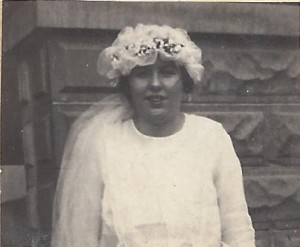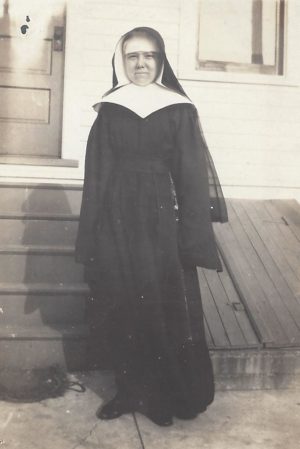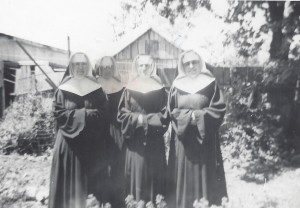Speech given by Sister Victoria Brohm on the occasion of
the Centennial at St. Edward, Jeffersontown,
January 27, 1984.
This paper or talk is the collaboration of about five of my former schoolmates and I. Namely, Harry Brohm, my brother, Mary Hawes, Mary First, and Amelia and Justina Heimann–we had fun recalling “Big Oaks from little acorns grow” from 26 students to over 500 and the school could be twice the size. “They that instruct others unto justice shall shine as stars throughout eternity.” Daniel 12:3.
Church and original school at St. Edward, Jeffersontown.
Either of these quotes could be elaborated on until time should be no more, but I am attempting in my feeble way to say a few things about the years of St. Edward’s School between the years of 1912 to 1921. These are the years when I attended and of which I am most familiar.
We know the school opened its doors for the first time in 1907 with an enrollment of 26 pupils. Sister Jerome of the first sisters here often told me I was a babe in my mother’s arms the first time she saw me. Those six years passed in a hurry and now I am ready to be a first grade student. Now, I wonder how you would feel if you were a first grade student and a Sister (of whom you had seen so few) would say: “Say the Angelical Salutation,” I was petrified but managed to say tearfully, “I don’t know it.” Then she said: “Do you know the Hail Mary?” Oh yes,” I said amidst smiles, “I say it all the time, mama taught it to me.” and so I rattled it off.
At that time the Sisters came from Mt. St. Angela’s on Newburg Road. They walked through slush, ice and snow through what is now Speed Avenue to catch the Interurban car on Bardstown Road. Some of us were always on the corner to meet them and carry a little black bag, which they brought with them for their personal needs.
Now above the front door was a sign which said: St. Edward’s School–it is the same one hanging there now–I remember some of the big boys pointing to it laughing and snickering and saying, “St. Edward’s Training Shop.”
Rosamond Margaret Brohm on the day of her entrance into the novitiate in 1923 and became Sister Mary Victoria.
Inside the building was a front hall, where wearing apparel and lunch boxes were deposited and then two classrooms separated by folding doors, I’ll tell you about the doors later–but in each room was a big pot-belly stove, and often as my, brother said, “You had to strike a match to see if we had fire in the stove because it was so cold.” Picture all the children hovering around this big stove. We had double desks, which cost $3.00; blinds $2.50 and charts at $6.80. It all may have been crude, but we learned much there. Today we hear constant complaint about our school system, the students’ lack of knowledge, especially in Science and Math. Well, the complaint then could have been too much homework, too much memorization of Catechism questions, etc., etc., and on and on. But daily I thank the good God that I was disciplined and made to study.
Today, another complaint—the children know no geography. Well, if they had to memorize all state capitols and locations as we did–for instance–Maine, Augusta and the Kennebec; New Hampshire, Concord on the Merrimac; Massachusetts, Boston on Boston Harbor and on through all the states, capitols and know to which section of the country they belonged–would this satisfy the parents? Historical memorization was quite the same but perhaps a little broader.
Then we were exposed to Spelling Bees–reading of monthly report cards with the parents and other guests present. Along with the report card reading, we had a little program consisting of songs, poems and piano duets. Sister Celestine taught music (piano) to about six or eight of us for 50¢ a lesson (one hour); this gave them a little extra money. Now this is when the folding doors were opened. For big plays and operettas we build a stage in the front of the room, used sheet for curtains and improvised many things. This is when I got a yen for drama and majored in it in later years.
Sister Mary Victoria’s teacher Sister Mary Celestine Cecil
Poetry—both pastor and teachers insisted on memorization of poetry and for this I will never cease thanking God. In poetry we learned the beauty of God’s world around us, and that has stayed with me these many years and with others with whom I reminisced. And the other day I read this about beauty–“Beauty is the poor person’s moat attainable treasure and to be a minister of beauty takes no special education, diplomas, or certification. Neither does it requite a commissioning ceremony.”
Then there were the beautiful Church services; we learned to sing Vespers in Latin; we had Vespers every Sunday at 2:00 p.m. When I entered the convent this was nothing new–we had been singing Vespers since I was nine years old.
Forty Hours with so many priests, exposition, flowers, incense at Benediction–I can still smell the fragrance; marching in procession, strewing flowers, first Holy Communion, beautiful hymns–a new relationship with God. Then a First Mass–Father Fanelli in 1917–then Father Allegier after I left home. I imagine the McKenna property is still echoing the voices of all of us from our school picnics. What a wholesome time we had!!
And the discipline–I remember being sent home for having on a short dress and socks; we weren’t supposed to wear socks, so I went across the street to Riley’s store and bought me a pair for a quarter and went back to school. Mary First had on a short dress and Sister asked, “Why didn’t you make your dress longer.” Mary said, “My mother didn’t have enough material.” And when Sister called the roll in the morning, we didn’t just say “Present.” We said, “Present at Mass with homework performed or not performed.”
Father Reverman called Mary Hawes and me “Sunbeam and Sunshine” because we were always laughing; we all loved him for he took so much interest in the students and would offer prizes for good work. One time he assigned us Composition work such as, “Write a 25 page dialogue between a Catholic and a non-Catholic (we had about nine churches and only one Catholic Church); he wanted to be sure we knew what we were about. Another time he assigned this one–“A Visit to the President and to the Halls of Congress”–25 pages (25 must have been his lucky number).
Father Reverman had a horse named Ned. My brother, Harry Brohm and Henry Karcher had charge of him; they cleaned out the stable and harnessed him to the buggy for Father to go on sick calls, to the bank at Buechel, etc. Of course, they expected a tip–but never a penny; we were taught to be Church.
People from a distance rode the Interurban car to church on Sundays; it came at 7:00 a.m. on Sunday. Mass began at 7:00 a.m. and it usually lasted about one hour, but sometimes longer. The motorman on the 8:00 o’clock car would blow his whistle loud and long–people would get up and go out, leaving Father Reverman with practically an empty church.
I could write fifty to a hundred pages but now I’ve come to 1921 when Father Reverman, who later became Bishop Reverman, was to be changed. There was sorrow all around. Miss Hattie, his housekeeper, I suppose got tired of all the crying and wailing and remarked, “Why such a disturbance, they all have the same power!”
Sisters Mary Otho Abell, Mary Beatrice Donohue, Mary Louise Riney, Mary Victor Rogers in the backyard at old St. Edward in this undated photograph.
Father Reverman was educated in Europe; he had a reading knowledge of 11 languages and spoke 7 fluently. I remember on one occasion we were taught hymns in four different languages so that the people of different nationalities who attended could hear a hymn in their native tongue–this was German, French, Latin, Italian and of course, English. Mrs. Reverman, Father’s mother, lamented the fact that her “Te-a-dor” had such a small parish and that he was so brilliant. Well, on April 24,t 1921, on the very day of his mother’s funeral, he was assigned to St. Francis of Assisi Parish, but as far as I can remember, he didn’t leave J-town until school closed which was late in June—if he left in April he came back for the closing of school in late June. Our program was at night. I well remember because I had the privilege of giving the farewell address; it went something like this:
“To meet in Heaven, how sweet the thought
When life’s short years are passed.
No more to meet, no more to part
To meet in Heaven at last.”
The words of this little poem seem very appropriate for this occasion, for the time of parting has come as it must to all things. My happy school days have at last come to an end—and now it seems that, I mast end for my time is up, and I, Thank you!




Comments
I graduated from St. Edward in 1963. I have been teaching there since 1971 as a fourth graded teacher/resource/special needs coordinator. I taught the fourth grade for 25 years and for the past 19 years have been the resource & special needs coordinator. My heart is and always will be with St. Edward’s.
How sweet! “I thank the good God that I was disciplined and made to study.”
I grew up across the street from St. Edward Church and School on Sue Helen Drive. Some of my favorite memories are bike rides with Father “B”, 5th grade with Mrs. Hettie Alcorn, 6th Grade with Mrs. Mary Risen, Youth Group and then teaching CCD under Sr. Jeanette Bowling.